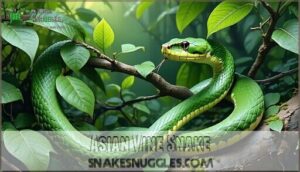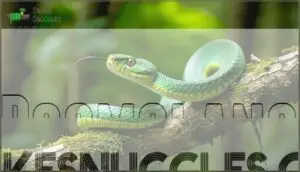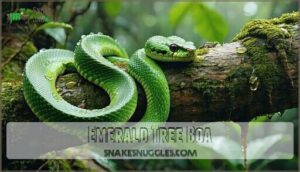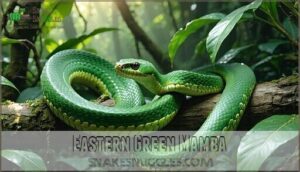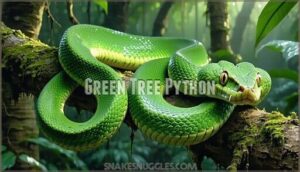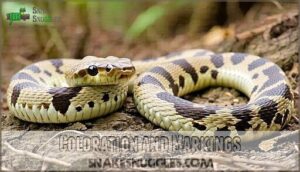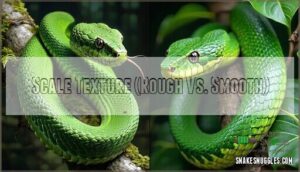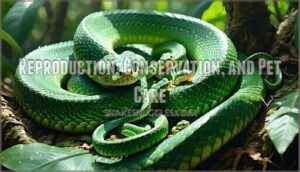This site is supported by our readers. We may earn a commission, at no cost to you, if you purchase through links.

North America’s rough green snake hunts insects in woodland canopies, and the smooth green snake glides through grasslands. Africa’s boomslang displays vivid green males, though their bite packs deadly venom. The eastern green mamba strikes with lightning speed from coastal trees.
South America’s green anaconda dominates as one of the world’s largest serpents, reaching 20 feet in swampy waters. Each species showcases nature’s green-scaled artistry through different hunting strategies and habitat preferences.
Table Of Contents
- Key Takeaways
- Most Popular Green Snake Species
- Distinctive Physical Features of Green Snakes
- Geographic Range and Natural Habitats
- Diet, Behavior, and Daily Life
- Reproduction, Conservation, and Pet Care
- Frequently Asked Questions (FAQs)
- What is the average lifespan of green snakes?
- Can green snakes be kept as pets?
- What are the ideal living conditions for green snakes?
- How do green snakes defend themselves?
- Are there any common misconceptions about green snakes?
- What diseases commonly affect green snakes?
- How long do green snakes typically live?
- Can green snakes change their color seasonally?
- What predators hunt green snakes in wild?
- How do green snakes communicate with others?
- Conclusion
Key Takeaways
- You’ll find green snakes on every continent except Antarctica, ranging from tiny 3-foot rough green snakes to massive 20-foot green anacondas that dominate their aquatic environments.
- You can’t assume all green snakes are dangerous – while eastern green mambas pack lethal venom, species like rough green snakes and smooth green snakes are completely harmless to humans.
- You’ll notice these snakes have perfected camouflage through millions of years of evolution, with their green coloration providing near-perfect concealment in forests, grasslands, and wetland vegetation.
- You should research species-specific care requirements thoroughly if considering a green snake as a pet, since they need specialized humidity, temperature gradients, and diet that many don’t adapt well to in captivity.
Most Popular Green Snake Species
You’ll discover eight striking green snake species that showcase nature’s amazing adaptations for camouflage and survival.
From the needle-thin Asian vine snake (Ahaetulla nasuta) all the way up to the colossal green anaconda (Eunectes murinus), each species has evolved fascinating traits and hunting styles that help them thrive in their environments.
Asian Vine Snake
Why love the Asian vine snake? Ahaetulla prasina mastered camouflage effectiveness in Southeast Asia’s treetops. These venomous snake species stretch pencil-thin with striking arboreal adaptations.
You’ll find them hunting specific dietary specifics like lizards and frogs. Their temperament traits remain generally non-aggressive despite venomous nature. Conservation status stays stable across their range.
Boomslang
You’ll find the Boomslang among Africa’s most dangerous venomous snake species. This SubSaharan Africa native displays striking color variation, with males showing bright green coloration.
Boomslang venom causes severe bleeding disorders in victims. Their African habitat spans woodlands and savannas where they hunt birds and eggs.
Females lay a small egg clutch in concealed locations. The Boomslang diet includes birds, small mammals, and frogs.
Emerald Tree Boa
The emerald tree boa showcases perfect arboreal adaptation in Amazon Basin rainforests. Their Amazonian habitat spans South America’s dense canopies.
These snake species display considerable constriction strength when hunting birds and mammals. Neonates’ coloration differs from adults, starting reddish-brown before developing emerald green scales.
Captive breeding programs help maintain these stunning arboreal snakes in collections worldwide.
Eastern Green Mamba
You’ll quickly recognize the Eastern Green Mamba among Africa’s most feared venomous snakes. This arboreal predator inhabits coastal habitats across eastern and southern Africa, using clever hunting strategies to catch birds and small mammals.
- Potent neurotoxic effects from venom toxicity cause paralysis and breathing difficulties
- Thrives in coastal forests with populations reaching three individuals per hectare
- Sedentary ambush hunters that wait patiently for prey to approach
Mamba conservation efforts focus on protecting these beautiful green snakes’ forest habitats.
Green Tree Python
Native to New Guinea and northern Australia, the Green tree python (Morelia viridis) showcases striking Arboreal Adaptations. You’ll notice its distinctive Diamond Head shape and powerful Prehensile Tail, perfect for moving through Snake species habitats. Color Variations range from bright emerald green adults to yellow or red juveniles, with Captive Breeding requiring females at least 3½ years old. They thrive in tropical rainforest habitats, including both lowland and montane regions.
| Feature | Description | Habitat Detail |
|---|---|---|
| Head Shape | Diamond-shaped for precision strikes | Arboreal snake habitats |
| Tail Function | Prehensile for gripping branches | New Guinea rainforests |
| Adult Colors | Emerald green with blue markings | Tree canopy dwelling |
| Juvenile Colors | Yellow, red, or orange patterns | Protected forest layers |
| Size Range | 4-6 feet when fully mature | Dense vegetation zones |
Rough Green Snake
Throughout the southeastern United States, you’ll find the Rough Green Snake (Opheodrys aestivus), a nonvenomous snake species perfectly at home in backyard habitats. This green snake’s distinctive scale texture gives it the "rough" name, while its calm temperament makes encounters pleasant.
Its insect diet includes crickets, caterpillars, and spiders. US distribution spans from New Jersey to Texas, where these arboreal beauties spend days foraging near ponds and nights coiled in tree branches.
Smooth Green Snake
Smooth Green Snake (Opheodrys vernalis) scales feel like silk compared to their rough cousins. This nonvenomous snake species thrives in North America’s meadows and grasslands, where their scale smoothness helps them navigate dense vegetation. Three characteristics define them:
- Perfect camouflage tactics blend seamlessly with backyard habitats
- Insect diet makes them vulnerable to pesticide exposure
- Habitat loss threatens their populations a lot
You’ll spot these green snake gems hiding under logs in grassy areas.
Green Anaconda
When you encounter the massive Green Anaconda, you’re witnessing South America’s aquatic giant. This snake species shows striking aquatic adaptations, spending most of its time in marshes and swamps. Their size reaches astonishing proportions, with females growing substantially larger than males. Green Anacondas showcase unique characteristics through their semi-aquatic lifestyle and diet specialization.
| Feature | Details |
|---|---|
| South American Habitat | Amazon Basin wetlands and rivers |
| Anaconda Size | Females: 15-20 feet, Males: 8-10 feet |
| Aquatic Adaptations | Eyes/nostrils on head top for swimming |
| Diet Specialization | Fish, birds, mammals, caimans |
| Conservation Status | Least Concern but habitat threatened |
Distinctive Physical Features of Green Snakes
Green snakes come in wildly different shapes and sizes depending on the species. Take green anacondas – these are absolute units with massive, muscular bodies. Compare that to Asian vine snakes, which look more like living green twigs stretched impossibly thin.
The texture differences are just as dramatic. Rough green snakes have bumpy, keeled scales that catch the light at different angles, giving them an almost sandpaper-like feel. Smooth green snakes are the complete opposite – their scales lie flat and create this glossy, almost mirror-like surface.
Size and Length Variations
Green snakes come in wildly different sizes depending on the species. Take rough green snakes – they max out around three feet. Compare that to green anacondas, which can stretch over twenty feet long.
Most species show clear size differences between males and females, with females typically growing larger.
How fast they grow really comes down to where they live and what they can catch to eat. Each species has basically evolved to fit perfectly into their specific corner of the world.
Coloration and Markings
Color variation among green snakes reveals nature’s artistry in action. Snake coloration ranges from vibrant emerald to subtle olive tones.
Green snake characteristics include distinctive white stripes, diamond patterns, and speckled markings that boost camouflage effectiveness. Scale iridescence creates rainbow-like reflections in sunlight.
Pattern development has specific purposes—markings help break up body outlines against foliage, making detection nearly impossible for predators and prey alike.
Body Shape and Adaptations
Green snake species show striking differences in body structure that match how they live. Tree-dwelling species like green tree pythons develop lean frames and gripping tails perfect for navigating branches. Water lovers such as green anacondas pack on muscle with thick, powerful bodies built for swimming.
These physical traits directly impact how well each species hunts and survives in its chosen habitat.
Scale Texture (Rough Vs. Smooth)
Green snakes like the Rough and Smooth varieties show fascinating differences in their scale textures.
These tiny surface structures do more than just look different – they actually help each species sense their surroundings and adapt to their preferred habitats.
The shedding process varies between rough and smooth scales. These evolutionary significance features help types of green snakes survive in specific habitats, with texture influencing camouflage effectiveness.
Geographic Range and Natural Habitats
Green snakes inhabit every continent except Antarctica, each species fine-tuned to its particular environment. From tropical rainforests to temperate grasslands, these adaptable reptiles have carved out their ecological roles.
Consider the diversity: emerald tree boas navigate South American canopy branches with precision, while massive green anacondas prowl through marshy waterways in search of prey.
North American Green Snakes
Two primary species inhabit North America: the Rough Green Snake and Eastern Smooth Green Snake. These non-venomous serpents thrive in diverse local ecosystems, from southeastern forests to northern grasslands.
Snake identification becomes important during backyard encounters, as habitat loss threatens their populations. Conservation efforts focus on protecting their woodland and meadow environments throughout North America.
African and Asian Green Snakes
You’ll find fascinating species across Africa and Asia that showcase striking adaptations. The Asian vine snake navigates complex rainforest canopies with vine snake venom that incapacitates prey. Meanwhile, the Eastern green mamba demonstrates astonishing mamba speed through coastal forests, contrasting with the Western green mamba’s rainforest preference.
- African Conservation efforts protect Western green mamba habitats in tropical rainforest regions
- Asian Habitats range from coastal lowlands to montane forests for diverse species
- Boomslang Diet varies seasonally, maintaining stable populations across Sub-Saharan Africa
South American Green Snakes
Central and South America hosts striking Amazonian species like the Emerald tree boa (Corallus caninus) and Green Anaconda. These boa constrictors showcase amazing snake camouflage and adaptation across rainforest canopies. However, habitat loss threatens their populations. Conservation efforts focus on protecting their diverse ecosystems.
The Green Anaconda’s impressive size and venom potency variations make South American green snakes particularly fascinating. The emerald tree boa relies on its prehensile tail for climbing and anchoring.
Arboreal Vs. Aquatic Habitats
Green snakes have figured out some pretty clever ways to survive in their chosen homes. Take emerald tree boas – they’ve gotten really good at life in the trees, developing strong grips and nimble climbing skills. Meanwhile, green anacondas went the opposite route, becoming powerhouse swimmers in rivers and wetlands.
- Climbing vs. Swimming: Tree snakes evolved lightweight bodies and those handy prehensile tails for gripping branches
- Different hunting styles: Up in the canopy, they’re waiting to ambush unsuspecting birds; down in the water, it’s all about snagging fish and frogs
- Blending in: Forest dwellers disappear among the leaves, while their aquatic cousins match the green of water plants perfectly
- What they’re up against: Whether it’s losing forest canopy or polluted waterways, both groups face serious habitat threats
Diet, Behavior, and Daily Life
Green snake species showcase remarkable hunting strategies. The Asian vine snake delivers lightning-fast strikes to catch lizards, while emerald tree boas use their muscular coils to overpower birds and small mammals.
These serpents adapt their daily routines based on their habitats, with arboreal species like green tree pythons remaining coiled on branches during daylight hours, while terrestrial forms such as rough green snakes actively hunt insects through vegetation.
Feeding Habits and Prey
Snake feeding habits vary dramatically across green species. Diet determines prey size selection and hunting strategies. Asian vine snakes target lizards and frogs, while emerald tree boas hunt birds and mammals.
Dietary adaptations include specialized venom effects in mambas versus constriction methods in pythons. Juvenile diets often focus on insects and smaller prey before shifting to adult feeding patterns. These predators demonstrate striking specialization.
Arboreal Vs. Terrestrial Behaviors
Behavioral adaptations reveal fascinating differences between arboreal snakes and their ground-dwelling cousins. You’ll notice climbing adaptations like prehensile tails in green tree pythons, while terrestrial species develop different locomotion styles for ground movement.
Arboreal snakes use specialized hunting strategies from branches, employing stealth and gravity. Their habitat preference shapes predator avoidance techniques, with tree-dwellers relying on camouflage among leaves while ground species use burrowing or rapid escape methods.
Venomous Vs. Non-Venomous Nature
Understanding venom potency matters for safety. You’ll encounter both venomous snakes and nonvenomous snakes in green species. Here’s what you need to know:
- Eastern Green Mamba venom contains neurotoxins and cardiotoxins, causing severe bite symptoms
- Western Green Mamba is less aggressive and less toxic than other species
- Antivenom availability varies by location and snake species encountered
- Snakebite treatment requires immediate medical attention for venomous species
Venom evolution varies a lot across green snake species.
Camouflage and Survival Strategies
Through millions of years of camouflage evolution, green snakes have perfected predator avoidance techniques. Arboreal snakes using color adaptation to match foliage perfectly.
Their habitat mimicry creates unnoticeable blends with snake habitats ranging from dense forests to grasslands. Snake coloration changes subtly based on environment.
Many species exhibit nocturnal behavior, staying motionless during daylight hours. This camouflage strategy defines snake habitats and behavior patterns across species.
Reproduction, Conservation, and Pet Care
You’ll find that green snake species have fascinating reproductive strategies, from the emerald tree boa’s live births to the green tree python’s protective egg-brooding behavior.
When you know how these snakes reproduce, what threats they face in the wild, and what they need to thrive in captivity, you can decide whether green snake ownership makes sense for you—and how to support conservation efforts that keep wild populations healthy.
Breeding and Egg-Laying Habits
Green snakes have some pretty interesting ways of making babies. Most species lay eggs – they’re what we call oviparous. But here’s where it gets cool: the emerald tree boa breaks the rules entirely and gives birth to live young instead.
Egg clutch size varies a lot between species. Incubation period usually ranges from 45-90 days depending on temperature.
Parental care is minimal in most species. Hatchling survival depends on environmental conditions and predator avoidance.
Conservation Status and Threats
Most green snake species face ongoing conservation challenges, though habitat loss remains their biggest threat. Climate change and invasive species disrupt these snakes’ delicate ecosystem balance.
Conservation efforts through CITES protections help combat poaching threats targeting popular species like emerald tree boas. While many snake species maintain stable populations, continued habitat destruction threatens their long-term survival in natural ecosystems.
Care Requirements for Pet Owners
Proper snake husbandry involves several critical factors. You’ll need an appropriate Enclosure Size and must maintain Humidity Control between 50-75% . Create a suitable Temperature Gradient with basking areas around 85-88°F.
Essential care components include:
- Consistent Feeding Schedule with gut-loaded insects
- Regular Veterinary Care for health monitoring
- Species-specific requirements for Green tree python and Emerald tree boa
- Specialized Snake habitats with climbing structures matching natural Snake diet and prey patterns
Handling and Temperament Considerations
Before handling any green snake species, you’ll need to understand their unique temperament patterns and venom potency levels. Venomous snakes like eastern green mambas require extreme snake bite safety protocols and zero interaction frequency.
Non-venomous reptiles show better docility factors, though many green snake habitats stress these shy creatures. Always maintain a safe enclosure and minimal handling approach for best snake species care.
Frequently Asked Questions (FAQs)
What is the average lifespan of green snakes?
Life expectancy varies considerably among species. Rough green snakes can live up to 15 years in captivity, while smooth green snakes typically survive around 6 years.
Wild populations rarely exceed 6 years due to environmental pressures.
Can green snakes be kept as pets?
You can keep some green snake species as pets, but they require specialized care, including proper humidity, temperature, and diet.
Many green snakes are wild-caught and don’t adapt well to captivity.
What are the ideal living conditions for green snakes?
You’ll need species-specific temperature gradients, humidity levels, and UV lighting. Arboreal species require vertical space with branches, while terrestrial ones need horizontal floor space. Research your specific snake’s requirements carefully.
How do green snakes defend themselves?
Green snakes use several defense strategies when threatened. You’ll see them rely on camouflage, freeze responses, rapid escape, threat displays, biting, and releasing musk to deter predators effectively.
Are there any common misconceptions about green snakes?
You’ll often hear that all green snakes are venomous, but that’s completely false. You can’t identify venomous species by triangular head shape alone.
Many people think snakes are slimy since they look shiny, when their skin’s actually smooth and dry.
What diseases commonly affect green snakes?
When a veterinary biologist examined a captive emerald tree boa showing weight loss, they discovered infectious stomatitis, parasites, blister disease, inclusion body disease, respiratory disease, and septicemia.
You’ll encounter these alongside Snake Fungal Disease and fungal infections affecting skin and respiratory systems.
How long do green snakes typically live?
Lifespan varies considerably among different species you’ll encounter. Smooth green snakes live about 6 years, while northern rough green snakes survive 5-8 years.
Green rat snakes can reach 12-20 years. Being kept in captivity usually extends their lives considerably.
Can green snakes change their color seasonally?
Most species don’t change color seasonally, though some undergo ontogenetic changes. Green tree pythons are born red or yellow, becoming green as adults.
This helps them provide camouflage in different habitats used by juveniles and adults.
What predators hunt green snakes in wild?
You’ll find that birds like hawks and crows hunt green snakes, alongside larger snakes such as milk snakes and mammals including raccoons, foxes, and bears.
How do green snakes communicate with others?
You’ll notice green snakes use chemical signals, vibrations, and body language to talk. They release pheromones to share territory info and detect ground vibrations through their bellies.
Conclusion
Absolutely breathtaking creatures await your discovery when exploring popular snake breeds that are green! You’ve now encountered nature’s most striking emerald serpents, from the massive anaconda’s aquatic dominance to the delicate vine snake’s arboreal precision.
Each species demonstrates impressive evolutionary adaptations through their vibrant coloration, specialized hunting techniques, and unique habitat preferences.
Whether you’re fascinated by venomous mambas or gentle rough green snakes, these reptiles showcase biodiversity’s astounding artistry across global ecosystems.
From venomous mambas to gentle rough green snakes, these reptiles showcase biodiversity’s astounding artistry across global ecosystems
- https://explorer.natureserve.org/Taxon/ELEMENT_GLOBAL.2.102569/Opheodrys_aestivus
- https://srelherp.uga.edu/snakes/rough-green-snake/
- https://www.floridamuseum.ufl.edu/florida-snake-id/snake/rough-greensnake/
- https://conservewildlifenj.org/?species=opheodrys-aestivus
- https://animaldiversity.org/accounts/Opheodrys_vernalis/

